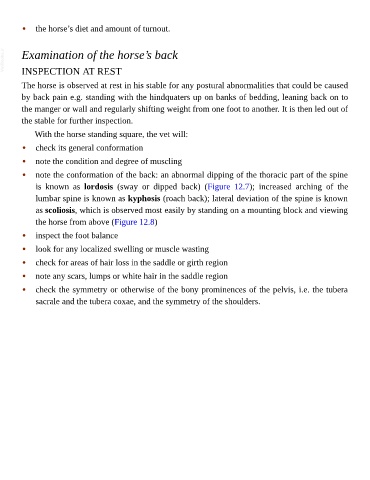Page 538 - The Veterinary Care of the Horse
P. 538
• the horse’s diet and amount of turnout.
VetBooks.ir Examination of the horse’s back
INSPECTION AT REST
The horse is observed at rest in his stable for any postural abnormalities that could be caused
by back pain e.g. standing with the hindquaters up on banks of bedding, leaning back on to
the manger or wall and regularly shifting weight from one foot to another. It is then led out of
the stable for further inspection.
With the horse standing square, the vet will:
• check its general conformation
• note the condition and degree of muscling
• note the conformation of the back: an abnormal dipping of the thoracic part of the spine
is known as lordosis (sway or dipped back) (Figure 12.7); increased arching of the
lumbar spine is known as kyphosis (roach back); lateral deviation of the spine is known
as scoliosis, which is observed most easily by standing on a mounting block and viewing
the horse from above (Figure 12.8)
• inspect the foot balance
• look for any localized swelling or muscle wasting
• check for areas of hair loss in the saddle or girth region
• note any scars, lumps or white hair in the saddle region
• check the symmetry or otherwise of the bony prominences of the pelvis, i.e. the tubera
sacrale and the tubera coxae, and the symmetry of the shoulders.

